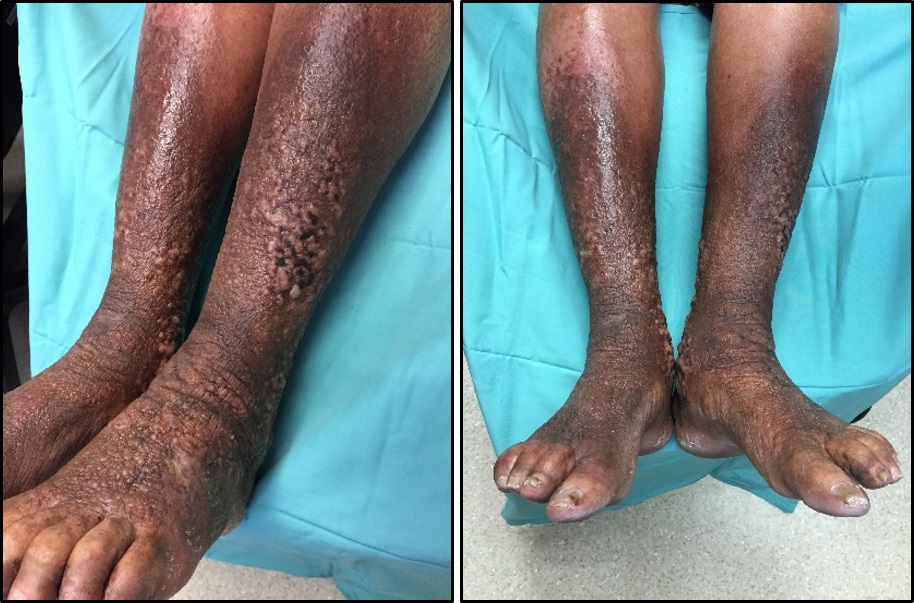What is stasis eczema?
Stasis eczema is a type of skin disease which affects the leg. Either single or both legs can be affected. It usually occurs in older people, who have poor circulation, where the valves in the veins weaken and could not stop the backflow of blood. This causes poor return of blood to the heart, which results in pooling of the blood at the legs, causing eczema.

Siapakah berisiko menghidapi penyakit stasis eczema?
Who are at risk of getting stasis eczema?
If you have any of the risk factors below, you are at higher risk of getting stasis eczema:
- Age above 50 years old
- Obesity
- Women
- Frequent pregnancies
- Venous insufficiency
- Varicose veins
- Deep vein thrombosis
- Previous injury or surgery to the area (where the veins had been removed)
- Congestive heart failure (where the heart cannot pump blood effectively)
- Renal failure
- Hypertension
- Standing or sitting for long period of time (for example during working)
- Little or no exercise
How can you reduce the risk of getting stasis eczema?
Exercise can reduce the risk of getting stasis eczema. Exercise can improve your circulation and strengthen your calf muscles. This helps return of blood to the heart and reduce pooling of blood at the legs. It also helps to reduce the body weight.It is also important to elevate the legs above the heart, preferably once every 2 hours for 15 minutes. While you are sleeping, you can keep your legs elevated with pillows. If your occupation involves standing or sitting for a long time, take regular breaks every 2-3 hours to do simple exercises like walking or stretching. Wearing a compression stocking can also reduce ankle swelling and help improve the circulation in your legs.
What are the signs and symptoms of stasis eczema?
Most people develop stasis eczema on their lower legs. Depending on the severity, patients will experience the following symptoms and signs:
Mild stasis eczema:
- Pain or ache on the feet when you stand or walk for a long period
- Ankle swelling, which tend to develop at the end of the day
- Ankle swelling reduced when you are asleep, but re-appear during the day
- Varicose veins (visible and engorged veins on the calves or thighs)
- Skin surrounding the feet and calves feel dry, itchy, painful and red
Moderate stasis eczema:
Apart from the above, patients will also experience the following:
- Increase in swelling, which may spread beyond the ankle, up to the calf level
- Dry, itchy, red, cracked and weepy skin around the ankles and lower legs
- Feet ulcer on the affected site
Severe stasis eczema:
As the disease progress, patient will experience the following:
- Skin on the affected area feels hard and verrucous
- Lower part of the calf shrinks, making the calf looks like an upside down bottle
- Colour changes on the affected area, the skin will either be hyperpigmented (darker) or hypopigmented (lighter)
Patients with stasis eczema are also at risk of getting allergy to the topical cream or ointment that they use on the skin. This is called contact dermatitis.
If the area affected by eczema is scratched, erosion may occur, which can lead to infection. The leg will become more swollen and red. This infection is called cellulitis.
What is the treatment of stasis eczema?
To reduce swelling in the legs and to improve blood circulation, patients are advised to wear a special sock (compression stocking) during the daytime. Swollen feet can also be reduced by elevating the feet when sitting or sleeping (at a level higher than the position of the heart).
Eczema can also be treated by using moisturizing creams and steroid creams. It is important to use moisturizing creams that do not contain fragrances that can possibly cause allergy (contact dermatitis) in those patients at risk. Preservatives in creams may also cause contact dermatitis. If the skin is very itchy, anti-histamine medications can be taken to reduce the itchiness. Patients are advised not to scratch the affected area to prevent infection.
If there are signs of infection (cellulitis), such as the feet become more swollen and red, antibiotics will be prescribed by a doctor.
Wound (ulcer) needs to be treated carefully, using appropriate cleanser and dressing.
If you have varicose veins, your doctor may recommend surgery to remove the affected vein. This can reduce the symptoms of stasis eczema.
What can patients do to reduce the symptoms and signs of stasis eczema?
- Elevate the feet at a level higher than the heart
- It is advisable to do this for 15 minutes, every 2 hours
- If your job requires a lot of sitting or standing, always find time to walk for about 10 minutes every 2 hours
- Get plenty of exercise
- Choose the right clothing material – loose-fitting and made of cotton
- Avoid tight shirt or pants, which can impede blood circulation
- Wear special stocking (compression stocking) during the day
- It can help improve blood circulation
- Socks can be removed when you are sleeping
- Use creams as advised by your doctor
- Make sure the skin is well moisturized by using adequate moisturizers
- Avoid scratching the eczematous skin – this can cause skin sores and leads to infection
References
- Rook’s Textbook of Dermatology (8th Edition). Chapter 23.1
- Fitzpatric’s Dermatology in General Medicine (8th Edition)
- Stasis eczema. www.aad.org
| Last Reviewed | : | 23 August 2019 |
| Writer/Translator | : | Dr. Azura bt. Mohd Affandi |
| Accreditor | : | Datin Dr. Asmah bt. Johar |
| Reviewer | : | Dr. Nazatul Shima bt. Abd Rahim |







